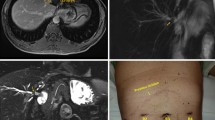Abstract
Benign bile duct stricture poses a significant challenge for gastroenterologists and general surgeons due to the inherent nature of the disease, difficulty in sustaining long-term solutions and fear of pitfalls in performing biliary tract operations. Operative management with an open biliary bypass is mainly reserved for patients who have failed multiple attempts of endoscopic and percutaneous treatments. However, recent advances in minimally invasive technology, notably in the form of the robotics, have provided a new approach to tackling biliary disease. In this technical report, we describe our standardized method of robotic choledochoduodenostomy in a 59-year-old woman with history of Roux-en-Y gastric bypass who presents with benign distal common bile duct stricture following failure of non-operative management. Key steps in this approach involved adequate duodenal Kocherization, robotic portal dissection and creation of a side-to-side choledochoduodenal anastomosis. The operative time was 200 min with no intraoperative complications and estimated blood loss was less than 50 mL. No abdominal drains were placed. The patient was discharged home on postoperative day 1 tolerating regular diet and able to resume her usual activities within 1 week of her operation. A video is attached to this report.


Similar content being viewed by others
References
Frederiksen NA, Tveskov L, Helgstrand F, Naver L, Floyd A (2017) Treatment of common bile duct stones in gastric bypass patients with laparoscopic transgastric endoscopic retrograde cholangiopancreatography. Obes Surg 27(6):1409–1413
Malherbe V, Badaoui A, Huybrecht H, De Ronde T, Michel L, Rosière A (2009) Management of common bile duct stone late after laparoscopic Roux-en-Y gastric bypass for obesity. Acta Chir Belg 109(6):820–823
Leppard WM, Shary TM, Adams DR, Morgan KA (2011) Choledochoduodenostomy: is it really so bad? J Gastrointest Surg 15:754–757
DuCoin C, Moon RC, Teixeira AF, Jawad MA (2014) Laparoscopic choledochoduodenostomy as an alternate treatment for common bile duct stones are Roux-en-Y gastric bypass. Surg Obes Relat Dis 10:647–653
Khajanchee YS, Cassera MA, Hammill CW, Swanstrom LL, Hansen PD (2012) Outcomes following laparoscopic choledochoduodenostomy in the management of benign biliary obstruction. J Gastrointest Surg 16:801–805
De Almeida ACM, Dos Santos NM, Aldeia FJ (1996) Choledochoduodenostomy in the management of common duct stones or associated pathology—an obsolete method? HPB Surg 10:27–33
Overby DW, Richardson W, Fanelli R (2014) Choledocholithiasis after gastric bypass: a growing problem. Surg Obes Relat Dis 10(4):652–653
Rosemurgy A, Ross S, Bourdeau T et al (2019) Robotic pancreaticoduodenectomy is the future: here and now. J Am Coll Surg 228(4):613–624
Sucandy I, Schlosser S, Bourdeau T et al (2019) Robotic hepatectomy for benign and malignant liver tumors. J Robot Surg. https://doi.org/10.1007/s11701-019-00935-0
Gravetz A, Sucandy I, Wilfong C et al (2019) Single-institution early experience and learning curve with robotic liver resections. Am Surg 85(1):115–119
Funding
This paper was not funded in part or in whole by any organization.
Author information
Authors and Affiliations
Corresponding author
Ethics declarations
Conflict of interest
Annie Laurie Benzie MD, Iswanto Sucandy MD, Janelle Spence BA, Sharona Ross MD and Alexander Rosemurgy MD declare that they have no conflict of interest to report with this study.
Ethical standards
All procedures performed in studies involving human participants were in accordance with the ethical standards of the institutional and/or national research committee and with the 1964 Helsinki Declaration and its later amendments or comparable ethical standards. This article does not contain any studies with animals performed by any of the authors.
Informed consent
Written informed consent was obtained from the patient for publication of this study. A copy of the written consent is available for review upon request.
Additional information
Publisher's Note
Springer Nature remains neutral with regard to jurisdictional claims in published maps and institutional affiliations.
Electronic supplementary material
Below is the link to the electronic supplementary material.
Supplementary material 1 (MP4 310270 kb)
Rights and permissions
About this article
Cite this article
Benzie, A.L., Sucandy, I., Spence, J. et al. Robotic choledochoduodenostomy for benign distal common bile duct stricture: how we do it. J Robotic Surg 13, 713–716 (2019). https://doi.org/10.1007/s11701-019-00957-8
Received:
Accepted:
Published:
Issue Date:
DOI: https://doi.org/10.1007/s11701-019-00957-8




